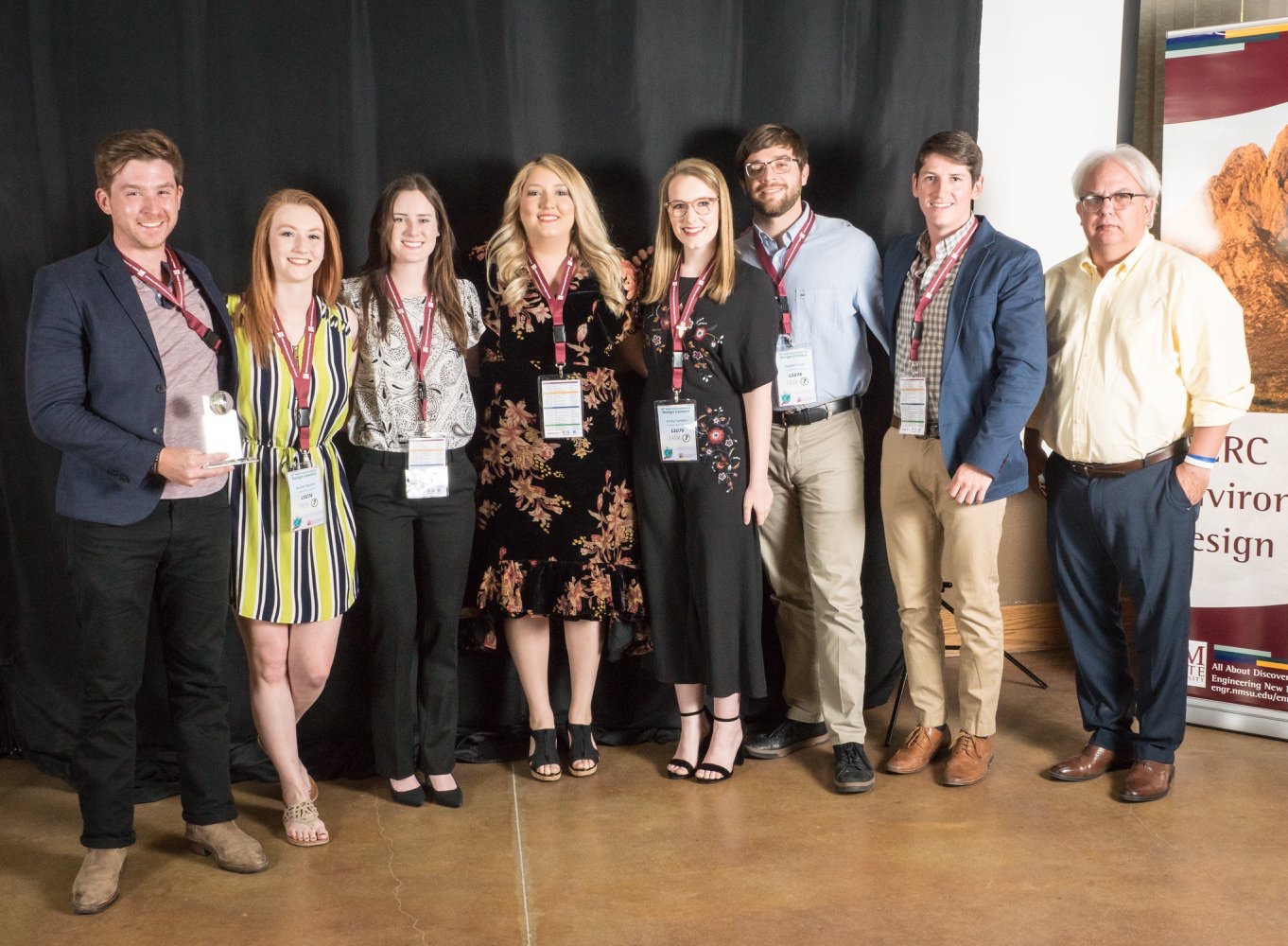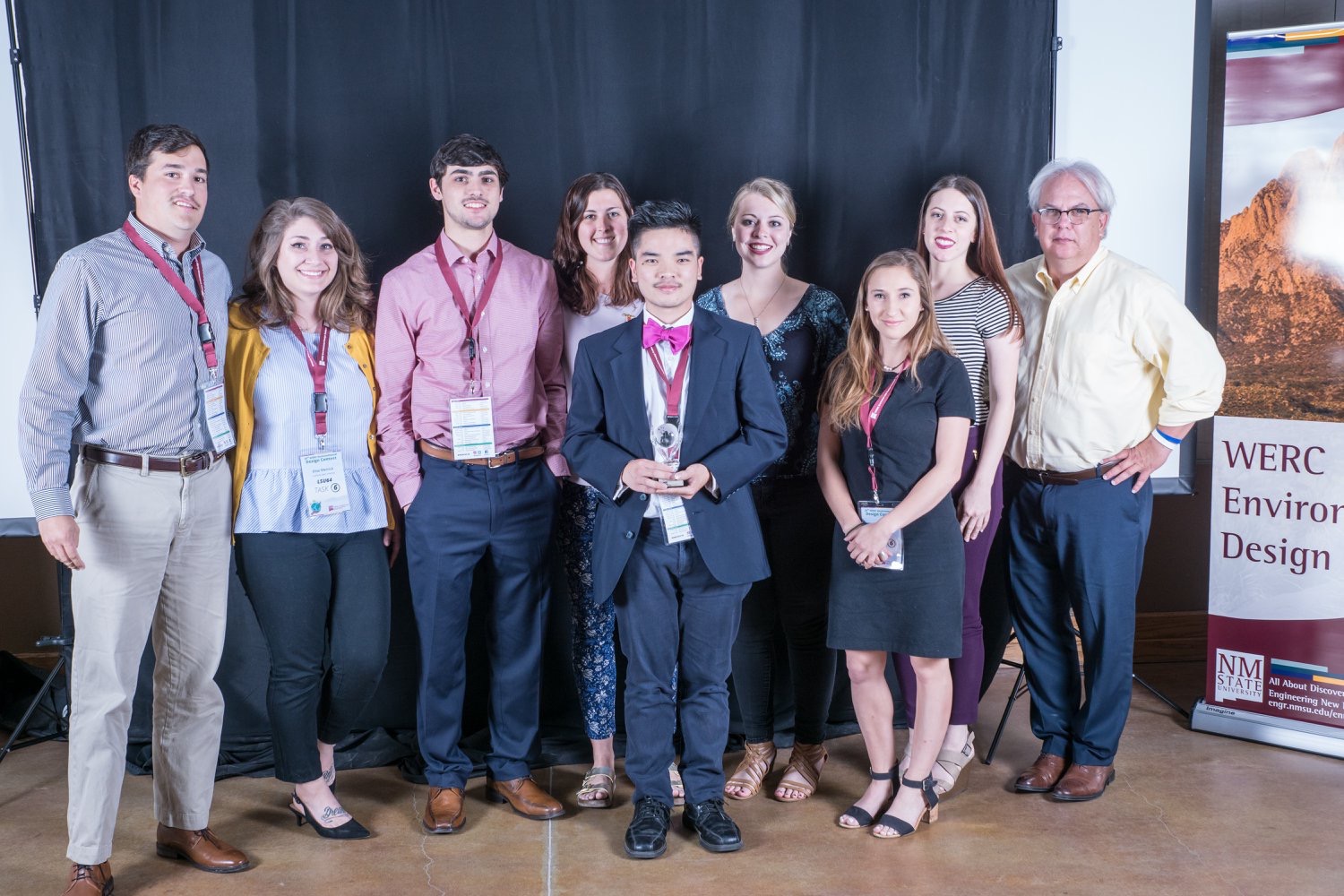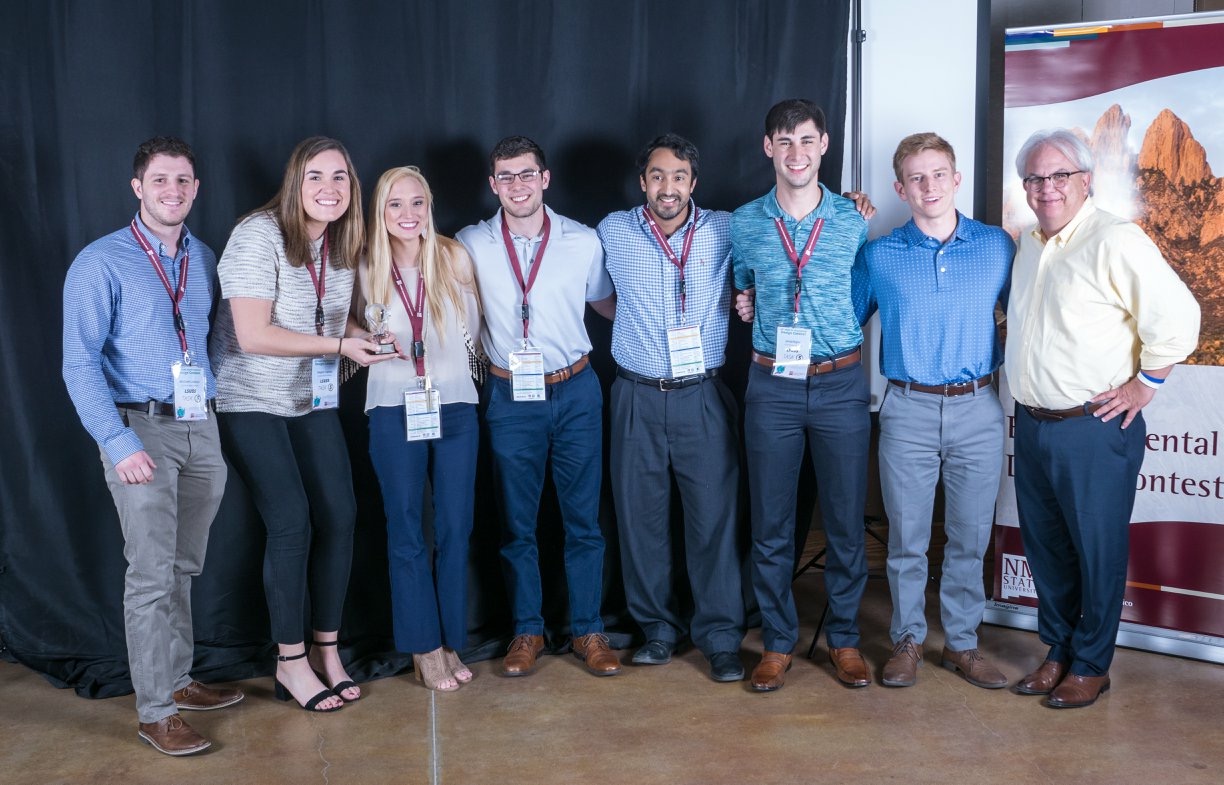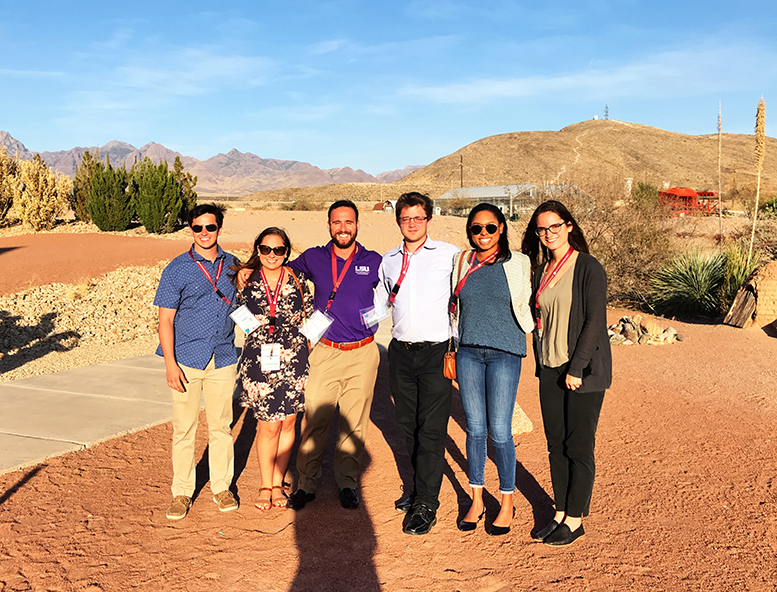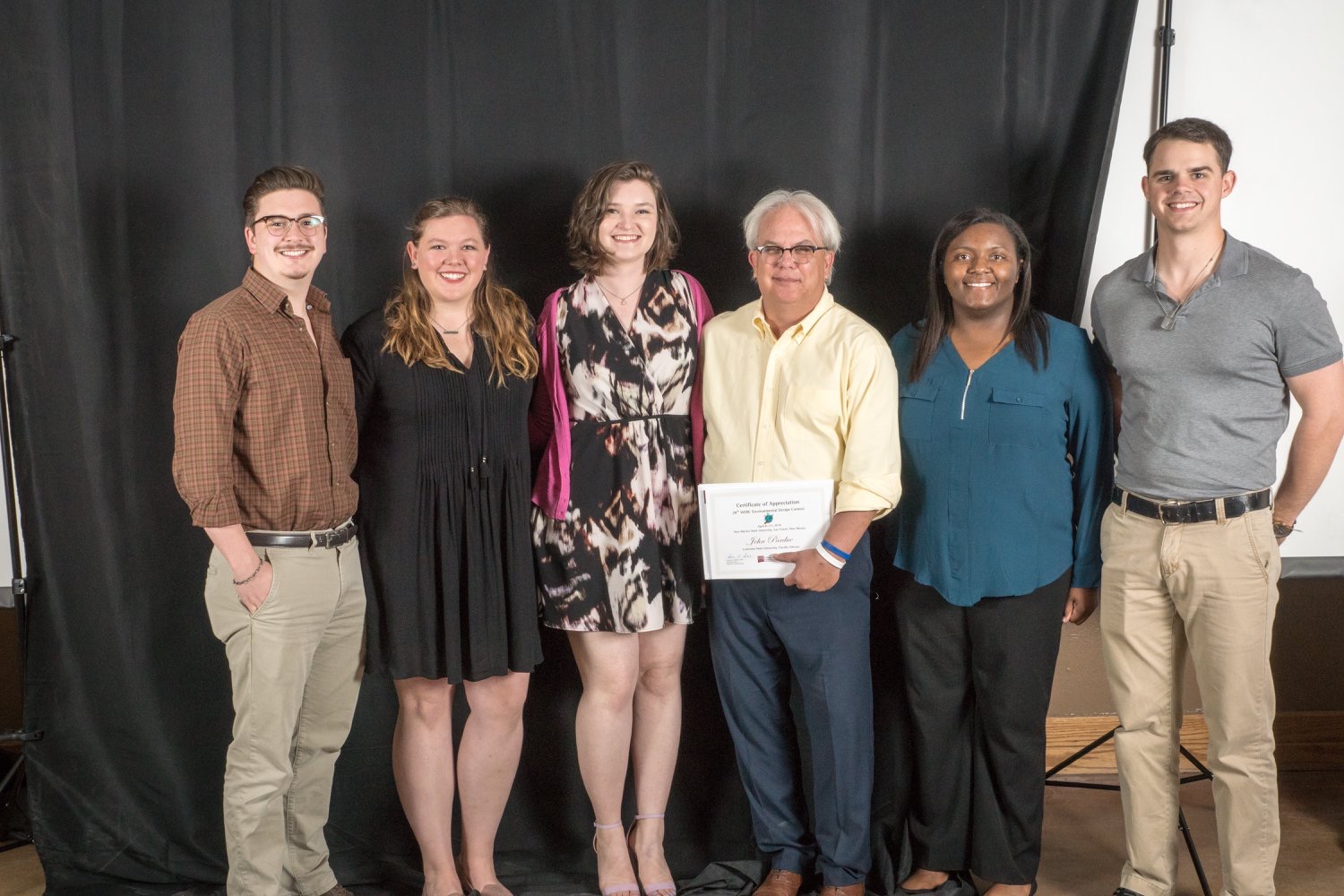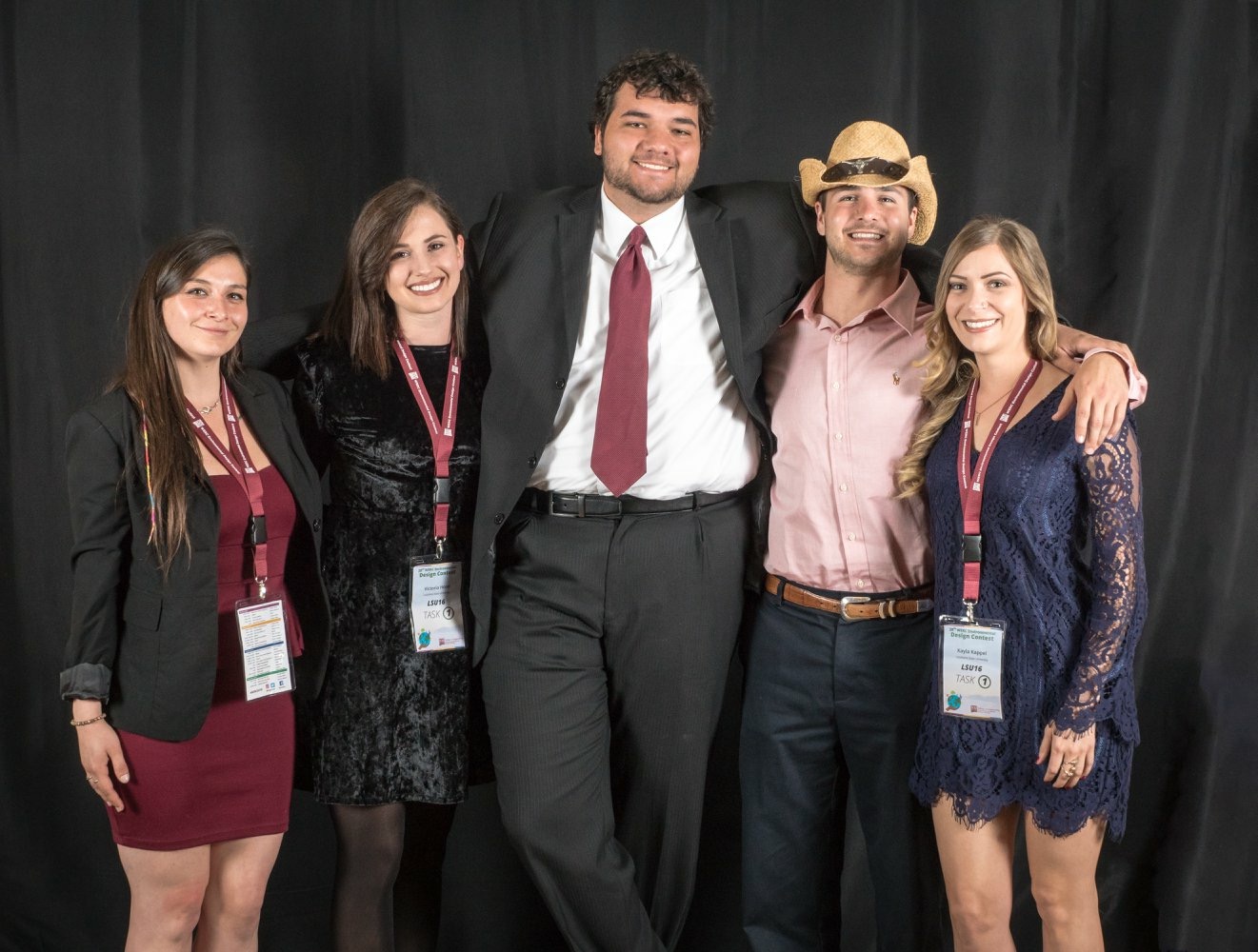LSU Environmental Engineers Win Awards at WERC Competition
BATON ROUGE – LSU Environmental Engineering students recently traveled to Las Cruces, N.M., to compete in the 28th Annual WERC (Waste-management Education Research Consortium) Environmental Design Contest, a competition that brings industry, government, and academia together in search of improved solutions to environmental challenges.
This year, a record 38 LSU students on six teams competed against teams from the University of Arkansas, University of Idaho, Cal Poly-San Luis Ebispo, Cal State-Fullerton, Cal-Riverside, University of New Hampshire, Montana Tech, University of Connecticut, Bridgeport University, New Mexico State University, and Ohio University. Three of the LSU teams won awards.
From left are Harris Bienn, Rachel Heuisler, Brooke Weyenberg, Noël Philley, Emily Franklin, Stephen Cook and Kyle Dugas.
Analyzing the Flooding Vulnerability of an At-Risk Neighborhood in New Orleans, Louisiana, Using Community-Sourced Data—Judges Award
The flooding vulnerability project was part of a new initiative with the Office of Resilience and Sustainability in the City of New Orleans Mayor’s Office. Projects were developed with input from the mayor’s staff to target problems of importance to New Orleans and its residents. The flooding vulnerability project’s goal was to create a community-based reporting system that would target clogged catch basins which contribute to stormwater flooding in the Gentilly neighborhood.
The team—Harris Bienn of Baton Rouge; Noel Philley of Crossett, Ark.; Stephen Cook of Baton Rouge; Rachel Heuisler of Hanover, Penn.; Brooke Weyenberg of Destrehan, La.; Emily Franklin of Baton Rouge; and Kyle Dugas of Belle Chasse, La.—designed a QR code system that would be stamped on the 65,000 catch basins in New Orleans. Residents who see a clogged basin could scan the QR code with their phone, which would immediately take them to an online reporting system that would notify city officials about the problem. The team developed a working website and database reporting system and obtained a grant for the stormwater-modeling software PCSWMM, which allowed it to develop simulations to better understand the impacts of clogged basins. The judges were especially impressed by the application of the information to understanding the impact of social vulnerability on the incidence of flooding in Gentilly.
From left are Trevor Warner, Elise Melnick, Chris Totaro, Madison Mikes, Kim Pham, Sarah Mai, Morgan Barranco and Lacyn Touchard.
Direct Water Reuse—Peer Award
The Direct Water Reuse project was sponsored by the Bureau of Reclamation Brackish Groundwater National Desalination Research Facility. The objective of the team’s project was to produce drinking water directly from wastewater without an environmental buffer.
The LSU team—Kim Pham of Baton Rouge; Madison Mikes of New Orleans; Elise Melnick of Vancouver, Wash.; Morgan Barranco of Baton Rouge; Lacyn Touchard of Des Allemands, La.; Trevor Warner of Mandeville, La.; Chris Totaro of Metairie, La.; and Sarah Mai of Collierville, Tenn.—traveled to Los Angeles and Bossier City, La., to research highly efficient treatment and recycle systems. The team designed a system consisting of a membrane bioreactor coupled with a reverse osmosis system to provide redundant treatment for the wastewater. It received a peer award that acknowledged the creativity of their design.
From left are Michael Labatut, Megan Copsey, Jordan Espenan, Dylan Fontenot, Lee Babst, Jared Bigler and Daniel Huffines
Removal of Carbemazepine From Wastewater—Peer Award
The Removal of Carbemazepine From Wastewater project was sponsored by the U.S. Department of Agriculture and required teams to design a treatment system for carbemazapine, a drug used to treat epilepsy, that is poorly removed by current technical approaches.
The LSU team—Jared Bigler of Houma, La.; Megan Copsey of Greenville, S.C.; Dylan Fontenot of Baton Rouge; Daniel Huffines of Natchez, Miss.; Jordan Espenan of Belle Chasse, La.; Lee Babst of New Orleans; and Michael Labatut of Metairie, La.—successfully constructed a system that destroyed more than 95 percent of carbamazepine using a combination of ultraviolet light and hydrogen peroxide. The team was given a peer award that cited the sustainability of their design.
Other LSU Projects
From left are Dustin Brantley, Katie O’Quin, Jacob Vigh, Sam Reynolds, Sadé Simien and Katherine Savoy
The Ecological Reuse of Brownfield Sites project produced the highest score LSU has received at the WERC competition in the past 10 years. The project, which was sponsored by Freeport-McMoran, required teams to design an ecological reuse plan for a copper mine tailings site in Bisbee, Ariz., that included hiking trails and a stormwater capture and reuse system to produce an annual wildflower “superbloom” to attract ecotourists to the site. Team members included Jacob Vigh of Mandeville, La.; Katie O’Quin of Mandevile, La.; Sade Simien of Lafayette, La.; Katherine Savoy of Lafayette, La.; and Dustin Brantley of Lafayette, La.
From left are Andrew Roubion, Catarina Buettner, Lauren Featherston, Destiny Parker, and Brent Rome
The Treatment Enhancement of Mirabeau Water Garden project was sponsored by the Office of Resilience and Sustainability in the City of New Orleans Mayor’s Office. The objective of this project was to design stormwater treatment options and increase the solar power utilization in the Mirabeau Water Garden in the Gentilly District of New Orleans. The team—Lauren Featherston of Shreveport, La.; Andrew Roubion of Mobile, Ala.; Destiny Parker of Baton Rouge; Brent Rome of Destrehan, La.; and Catarina Buettner of Lafayette, La.—traveled often to Gentilly to design a bioswale and wetland treatment system to improve the quality of stormwater stored in the water garden. The group shared its design with city planners for potential inclusion in the water garden during construction.
From left are Chelsie Spadoni, Victoria Hood, Alex Pluta, Kyle Koch, and Kayla Kappel
The Water Reclamation System for the International Space Station project, sponsored by NASA, required student teams to develop a zero-gravity solution for accumulation of small amounts of ethanol and methanol in the ISS water recycling system. The LSU team—Alex Pluta of New Orleans; Chelsie Spadoni of Baton Rouge; Victoria Hood of Brusly, La.; Kayla Kappel of Baton Rouge; and Kyle Koch of Alexandria, La.—successfully designed a microbial electrochemical reactor to biologically treat ethanol and methanol at greater than 90 percent. The system will also generate electricity as the degradation of these impurities proceeds. The system was developed in the laboratory of LSU CEE Assistant Professor Xiuping Zhu.
Like us on Facebook (@lsuengineering) or follow us on Twitter and Instagram (@lsuengineering).
###
Contact: Libby Haydel
Communications Specialist
225-578-4840 (o)
